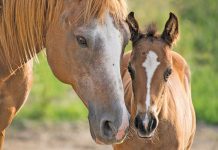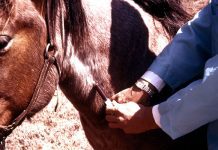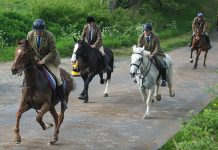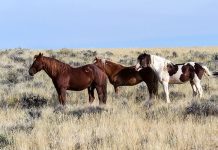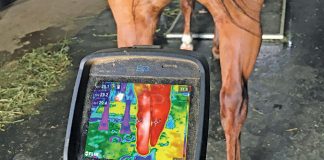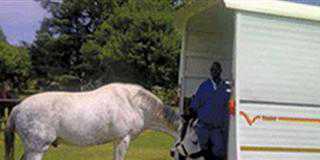Before you teach YOUR HORSE to tie up, he must learn to turn and face you when you enter a stable or paddock. Your horse must want to follow you. When your horse yields to the pressure of the lead rope – when you gently pull on the rope and your horse comes towards you to release the pressure – then he’s ready to yield to the pressure he’ll feel when tied up.
A horse that is used to being tied, won’t try to free himself, risking injury.
Choose a quiet spot, as a sudden fright can cause havoc. Always stay with the horse you’re tying until he’s comfortable with the process. To tie your horse you’ll need a well-fitted leather halter, a soft cotton lead rope, a lariat or lunge line, and a solid fence post.
Step one
Work in a lunge ring. Put on the head collar and clip the lunge line onto the ring below the chin. Reinforce the basics of restraint by asking your horse to yield to lateral pressure while lunging at a trot. Repeat this process at a gentle canter. A faster gait will excite your horse, so if he resists pressure and pulls back, make him trot by gently pulling on the lariat or lunge line. Gradually work up to a canter. Once your horse is obedient on both reins, he’s ready for step two.
Step two
Encourage your horse to yield to pressure from behind. This will reinforce the message that he must stop in response to backward pressure – a cue you’ll use when you lead him to the pole and ask him to halt. Stop on your horse’s right side. Send him out on a circle to trot. As he moves, place yourself about 4m behind him with your rope extended along his right side and behind him. Your horse may bend his neck and head to the side – this means he’s anticipating pressure.
Let the rope out. Apply a gentle pressure and say “whoa!” to stop your horse. Then ask him to yield to the pressure and turn his body to look at you. When your horse reacts correctly, reward immediately by releasing the pressure. Repeat until only the slightest pressure makes the horse turn to face you. Now repeat at canter.
Step three
Encourage him to bend away from you in response to pressure applied from the opposite side. It’s essential that your horse doesn’t associate you with the pressure, as the pressure will come from the post when he’s tied.Turn your horse to face the centre of the ring. Stand opposite the right hip, pass the rope along the left side of his neck and diagonally over his back towards the right hip. Now apply pressure on the rope until he turns his head to the left – away from you. Reward him by releasing the pressure.
Step four
Now your horse is ready to be tied. Lead him to the post so he’s standing about 4m perpendicular to it. Run the rope around the post once, level with the withers. This is the ideal tying height. Stand opposite the right hip and extend the rope until he steps towards the pressure. If he reacts by pulling back on the rope, release the rope and repeat steps two and three. As soon as your horse takes a step closer to the post, release the pressure to reward. When your horse repeatedly steps forward on the slightest pressure, switch sides and repeat.
Step five
Encourage your horse to move away from you, stop and bend towards the pressure, and step forward to relieve the pressure. This manoeuvre will simulate being tied to a pole.
Step six
When your horse can perform the side-switching sequence perfectly, tie him to the pole with a lead rope.
First remove the lariat and snap on the lead rope. Lead him to the post and loosely wrap the rope around it a few times, at eye level. Allow him to stand for a few seconds, then release the rope and reward. Gradually work up to a few minutes at a time over a few days. When he’s comfortable, unwrap the lead rope and tie using a slip knot.
E-mail Dr Mac c/o Chris Nel at [email protected].

